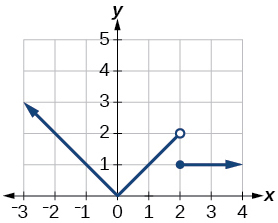1.2 Section Exercises
Verbal
1. Why does the domain differ for different functions?
2. How do we determine the domain of a function defined by an equation?
3. Explain why the domain of[latex]\text{ }f\left(x\right)=\sqrt[3]{x}\text{ }[/latex]is different from the domain of[latex]\text{ }f\left(x\right)=\sqrt[]{x}.[/latex]
4. When describing sets of numbers using interval notation, when do you use a parenthesis and when do you use a bracket?
5. How do you graph a piecewise function?
Algebraic
For the following exercises, find the domain of each function using interval notation.
6. [latex]f\left(x\right)=-2x\left(x-1\right)\left(x-2\right)[/latex]
7. [latex]f\left(x\right)=5-2{x}^{2}[/latex]
8. [latex]f\left(x\right)=3\sqrt{x-2}[/latex]
9. [latex]f\left(x\right)=3-\sqrt{6-2x}[/latex]
10. [latex]f\left(x\right)=\sqrt{4-3x}[/latex]
11. [latex]\begin{array}{l}\\ f\left(x\right)=\sqrt[]{{x}^{2}+4}\end{array}[/latex]
12. [latex]f\left(x\right)=\sqrt[3]{1-2x}[/latex]
13. [latex]f\left(x\right)=\sqrt[3]{x-1}[/latex]
14. [latex]f\left(x\right)=\frac{9}{x-6}[/latex]
15. [latex]f\left(x\right)=\frac{3x+1}{4x+2}[/latex]
16. [latex]f\left(x\right)=\frac{\sqrt{x+4}}{x-4}[/latex]
17. [latex]f\left(x\right)=\frac{x-3}{{x}^{2}+9x-22}[/latex]
18. [latex]f\left(x\right)=\frac{1}{{x}^{2}-x-6}[/latex]
19. [latex]f\left(x\right)=\frac{2{x}^{3}-250}{{x}^{2}-2x-15}[/latex]
20. [latex]\frac{5}{\sqrt{x-3}}[/latex]
21. [latex]\frac{2x+1}{\sqrt{5-x}}[/latex]
22. [latex]f\left(x\right)=\frac{\sqrt{x-4}}{\sqrt{x-6}}[/latex]
23. [latex]f\left(x\right)=\frac{\sqrt{x-6}}{\sqrt{x-4}}[/latex]
24. [latex]f\left(x\right)=\frac{x}{x}[/latex]
25. [latex]f\left(x\right)=\frac{{x}^{2}-9x}{{x}^{2}-81}[/latex]
26. Find the domain of the function[latex]\text{ }f\left(x\right)=\sqrt{2{x}^{3}-50x}\text{ }[/latex]by:
- using algebra.
- graphing the function in the radicand and determining intervals on the x-axis for which the radicand is nonnegative.
Graphical
For the following exercises, write the domain and range of each function using interval notation.
![Graph of a function from (2, 8].](https://s3-us-west-2.amazonaws.com/courses-images/wp-content/uploads/sites/3896/2019/05/14164150/95dc6ac68866233b3e7b8759a3cace0ad6b04c36.jpeg)
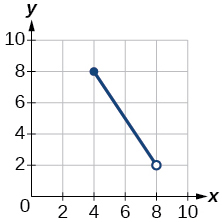
![Graph of a function from [-4, 4].](https://s3-us-west-2.amazonaws.com/courses-images/wp-content/uploads/sites/3896/2019/05/14164321/d2ad7e19347188f184abae277ccea56e04487569.jpeg)
![Graph of a function from [2, 6].](https://s3-us-west-2.amazonaws.com/courses-images/wp-content/uploads/sites/3896/2019/05/14164424/5a91a98938b451ec9dae67472073c03e8a6f842a.jpeg)
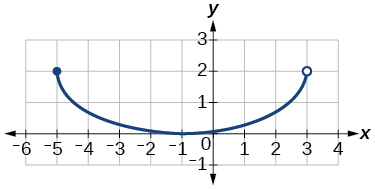
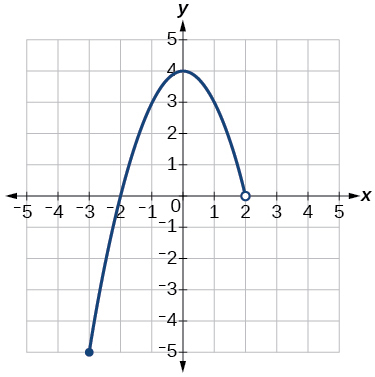
![Graph of a function from (-infinity, 2].](https://s3-us-west-2.amazonaws.com/courses-images/wp-content/uploads/sites/3896/2019/05/14171740/7f093175d882b9d10d3d3d0b120d6fca4892d673-1.jpeg)
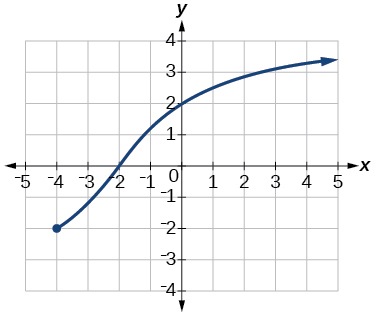
![Graph of a function from [-6, -1/6]U[1/6, 6]/.](https://s3-us-west-2.amazonaws.com/courses-images/wp-content/uploads/sites/3896/2019/05/14172009/a5dd835a635bda30403a7a85fa1948fafc101f4a.jpeg)
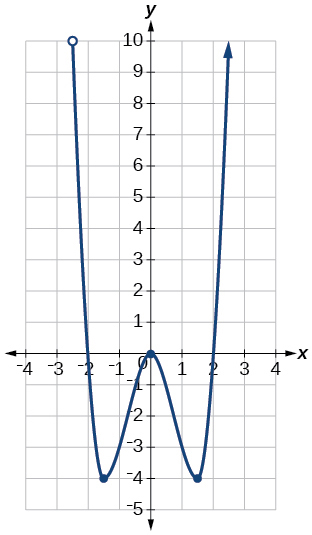
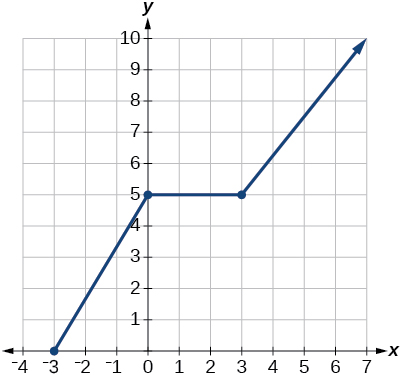
For the following exercises, sketch a graph of the piecewise function. Write the domain in interval notation.
38. [latex]f\left(x\right)=\bigg\{\begin{array}{lll}x+1\hfill & \text{if}\hfill & x<-2\hfill \\ -2x-3\hfill & \text{if}\hfill & x\ge -2\hfill \end{array}[/latex]
39. [latex]f\left(x\right)=\bigg\{\begin{array}{lll}2x-1\hfill & \text{if}\hfill & x<1\hfill \\ 1+x\hfill & \text{if}\hfill & x\ge 1\hfill \end{array}[/latex]
40. [latex]f\left(x\right)=\bigg\{\begin{array}{c}x+1\text{ }\text{ }\text{if}\text{ }\text{ }x<0\\ x-1\text{ }\text{ }\text{if}\text{ }\text{ }\text{ }x>0\end{array}[/latex]
41. [latex]f\left(x\right)=\bigg\{\begin{array}{ccc}3& \text{if}& x<0\\ \sqrt{x}& \text{if}& x\ge 0\end{array}[/latex]
42. [latex]f\left(x\right)=\bigg\{\begin{array}{c}{x}^{2}\text{ if }x<0\\ 1-x\text{ if }x>0\end{array}[/latex]
43. [latex]f\left(x\right)=\bigg\{\begin{array}{r}\hfill \begin{array}{r}\hfill {x}^{2}\\ \hfill x+2\end{array}\end{array}\text{ }\text{ }\begin{array}{l}\text{if}\text{ }\text{ }\text{ }\text{ }\text{ }x<0\hfill \\ \text{if}\text{ }\text{ }\text{ }\text{ }\text{ }x\ge 0\hfill \end{array}[/latex]
44. [latex]f\left(x\right)=\bigg\{\begin{array}{ccc}x+1& \text{if}& x<1\\ {x}^{3}& \text{if}& x\ge 1\end{array}[/latex]
45. [latex]f\left(x\right)=\bigg\{\begin{array}{c}|x|\\ 1\end{array}\begin{array}{l}\text{ }\text{ }\text{ }\text{if}\text{ }\text{ }\text{ }x<2\hfill \\ \text{ }\text{ }\text{ }\text{if}\text{ }\text{ }\text{ }x\ge 2\hfill \end{array}[/latex]
Numeric
For the following exercises, given each function [latex]f,[/latex]evaluate [latex]f\left(-3\right),\text{ }f\left(-2\right),\text{ }f\left(-1\right),[/latex] and [latex]f\left(0\right).[/latex]
46. [latex]f\left(x\right)=\bigg\{\begin{array}{lll}x+1\hfill & \text{if}\hfill & x<-2\hfill \\ -2x-3\hfill & \text{if}\hfill & x\ge -2\hfill \end{array}[/latex]
47. [latex]f\left(x\right)=\bigg\{\begin{array}{cc}1& \text{if }x\le -3\\ 0& \text{if }x>-3\end{array}[/latex]
48. [latex]f\left(x\right)=\bigg\{\begin{array}{cc}-2{x}^{2}+3& \text{if }x\le -1\\ 5x-7& \text{if }x>-1\end{array}[/latex]
For the following exercises, given each function[latex]\text{ }f,\text{ }[/latex]evaluate[latex]f\left(-1\right),\text{ }f\left(0\right),\text{ }f\left(2\right),\text{ }[/latex]and[latex]\text{ }f\left(4\right).[/latex]
49. [latex]f\left(x\right)=\bigg\{\begin{array}{lll}7x+3\hfill & \text{if}\hfill & x<0\hfill \\ 7x+6\hfill & \text{if}\hfill & x\ge 0\hfill \end{array}[/latex]
50. [latex]f\left(x\right)=\bigg\{\begin{array}{ccc}{x}^{2}-2& \text{if}& x<2\\ 4+|x-5|& \text{if}& x\ge 2\end{array}[/latex]
51. [latex]f\left(x\right)=\Bigg\{\begin{array}{ccc}5x& \text{if}& x<0\\ 3& \text{if}& 0\le x\le 3\\ {x}^{2}& \text{if}& x>3\end{array}[/latex]
For the following exercises, write the domain for the piecewise function in interval notation.
52. [latex]f\left(x\right)=\bigg\{\begin{array}{c}x+1\text{ }\text{ }\text{ }\text{ }\text{ }\text{ if}\text{ }\text{ }x<-2\\ -2x-3\text{ }\text{ }\text{if}\text{ }\text{ }x\ge -2\end{array}[/latex]
53. [latex]f\left(x\right)=\bigg\{\begin{array}{c}{x}^{2}-2\text{ }\text{ }\text{ }\text{ }\text{ }\text{ if}\text{ }\text{ }x<1\\ -{x}^{2}+2\text{ }\text{ }\text{if}\text{ }\text{ }x>1\end{array}[/latex]
54. [latex]f\left(x\right)=\bigg\{\begin{array}{c}2x-3\\ -3{x}^{2}\end{array}\text{ }\text{ }\begin{array}{c}\text{if}\text{ }\text{ }\text{ }x<0\\ \text{if}\text{ }\text{ }\text{ }x\ge 2\end{array}[/latex]
Technology
55. Graph[latex]\text{ }y=\frac{1}{{x}^{2}}\text{ }[/latex]on the viewing window[latex]\text{ }\left[-0.5,-0.1\right]\text{ }[/latex]and[latex]\text{ }\left[0.1,0.5\right].\text{ }[/latex]Determine the corresponding range for the viewing window. Show the graphs.
![Graph of the equation from [-0.5, -0.1].](https://s3-us-west-2.amazonaws.com/courses-images/wp-content/uploads/sites/3896/2019/05/14172642/e9ff86fef34aa7f3335b023686c29d96c31810c9.jpeg)
window:[latex]\text{ }\left[-0.5,-0.1\right];\text{ }[/latex]range:[latex]\text{ }\left[4,\text{ }100\right][/latex]
![Graph of the equation from [0.1, 0.5].](https://s3-us-west-2.amazonaws.com/courses-images/wp-content/uploads/sites/3896/2019/05/14172922/1958a0a7420a22e38d7733e4c3481051536b1e52.jpeg)
window:[latex]\text{ }\left[0.1,\text{ }0.5\right];\text{ }[/latex]range:[latex]\text{ }\left[4,\text{ }100\right][/latex]
56. Graph[latex]\text{ }y=\frac{1}{x}\text{ }[/latex]on the viewing window[latex]\text{ }\left[-0.5,-0.1\right]\text{ }[/latex]and[latex]\text{ }\left[0.1,\text{ }0.5\right].\text{ }[/latex]Determine the corresponding range for the viewing window. Show the graphs.
Extension
57. Suppose the range of a function[latex]\text{ }f\text{ }[/latex]is[latex]\text{ }\left[-5,\text{ }8\right].\text{ }[/latex]What is the range of[latex]\text{ }|f\left(x\right)|?[/latex]
58. Create a function in which the range is all nonnegative real numbers.
59. Create a function in which the domain is[latex]\text{ }x>2.[/latex]
Real-World Applications
60. The height[latex]\text{ }h\text{ }[/latex]of a projectile is a function of the time[latex]\text{ }t\text{ }[/latex]it is in the air. The height in feet for[latex]\text{ }t\text{ }[/latex]seconds is given by the function [latex]h\left(t\right)=-16{t}^{2}+96t.[/latex] What is the domain of the function? What does the domain mean in the context of the problem?
61. The cost in dollars of making[latex]\text{ }x\text{ }[/latex]items is given by the function[latex]\text{ }C\left(x\right)=10x+500.[/latex]
- The fixed cost is determined when zero items are produced. Find the fixed cost for this item.
- What is the cost of making 25 items?
- Suppose the maximum cost allowed is $1500. What are the domain and range of the cost function,[latex]\text{ }C\left(x\right)?[/latex]



